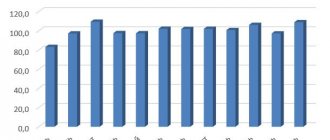The results of the production and financial activities of any Russian company must be reflected in reports submitted at the end of each reporting period to various authorities - from statistical departments and extra-budgetary funds to inspections of the Federal Tax Service. Accounting statements in our country are based on strictly regulated rules, united by a single abbreviation - RAS . Let's try to understand these complex specific definitions and learn about the requirements that they impose on the preparation of financial statements.
The difference is in the goals. IFRS when to use
When studying this issue, it should be noted that the difference between IFRS and RAS is marked by the very purpose of reporting. This is due to the conceptual foundations of international and domestic accounting. Thus, according to international standards, reporting is compiled solely to form an evaluative opinion of the investor and manager, that is, it must give a clear answer to the question: is the company profitable or not, what is its level of profitability, turnover, what happened during the reporting period to the assets and liabilities of the enterprise . In the Russian Federation, the approach is completely different: no one uses a balance sheet or other similar forms to decide whether to invest. Reporting in most cases is generated for external use by regulatory authorities - tax inspectorates.
What standard should companies apply? There is currently no clear definition at the legislative level. It is clear that firms with foreign capital use IFRS. Domestic enterprises have the right to choose. But when they make the transition to accounting according to international principles and reporting in accordance with them, then they must apply IFRS. Moreover, such a decision must be reflected in the accounting policy.
In turn, IFRS requires that a legal entity fulfill the following requirements:
- It is imperative to determine the first reporting that will be compiled according to the new standards;
- Draw up a preparatory form of only the balance sheet for the date when the transition is planned;
- Consider changes in accounting policies and implement them by special order of the manager;
- Study those areas of analysis that may constitute exceptions to the use of retrospective analysis during the preparation of financial statements;
- Prepare an explanation of the reasons for the transition from RAS to IFRS.
What does EBITDA mean and who might be interested in it?
The best way to understand the definition of EBITDA will be to decipher the abbreviation - earnings before interest, taxes, depreciation and amortization. Literally translated as “earnings before interest, taxes, depreciation and amortization.”
In other words, it is a special indicator that shows the profit or loss from the company's main activities (operating activities). To get the more familiar net profit, you need to pay off creditors, pay income tax to the state and take into account the depreciation of assets.
If there is a well-known and understandable net profit indicator, why calculate another one? We need EBITDA to understand how much profit the company's business directly brings. It gives an answer to the question whether the enterprise knows how to earn money, whether it is enough to pay interest on the loan, pay taxes, maintain assets: buildings, structures, machinery, equipment, etc.
To put it even more simply, EBITDA tells us how much the company would earn under ideal conditions: if it already had all its factories, the machines did not wear out, and the state introduced a zero tax rate for it. It takes into account only those funds that the enterprise actually has. It is measured in monetary units, in Russia - in rubles.
Comparing two enterprises based on net profit is not always correct. Each of them may have different taxation systems, depreciation calculation methods, and lending conditions. EBITDA allows you to analyze the core activities of the organization, without taking into account factors not directly related to it.
EBITDA is widely used among:
- analysts when preparing recommendations for the sale/purchase of securities;
- banks that prepare mergers and acquisitions;
- investors when comparing different companies and making investment decisions;
- management personnel when analyzing the enterprise’s activities over time, comparing it with competitors, and searching for optimal ways to solve strategic development problems.
EBITDA was developed in the 80s of the 20th century to analyze large industrial companies. Investment funds appeared on the market, buying up enterprises with good financial condition and expensive assets. This allowed them to pledge fixed assets to obtain bank loans. What was needed was an indicator that would compare different companies from the same industry and assess how capable they are of bearing the debt load.
Thus, the indicator provides answers to the following questions:
- How much cash flow does the company generate through operating activities and does it have enough money to service loans, pay taxes and maintain its assets?
- How to compare organizations with each other if they have different debt loads, depreciation policies, and tax rates?
09.12.2019
1 163
How to buy shares of Russian and foreign companies for an individual: a step-by-step guide
Hello, friends! Russians do not need to be taught to save. Look at our...
RAS and IFRS similarities and differences
When comparing IFRS and RAS, it should be noted that they have many fundamental features, in particular in terms of the following issues:
Prevalence of the content of an economic business transaction over its legal form
This means that in any form of reporting documents it is necessary to reflect the economic essence of the transaction being carried out, without paying special attention to the documentation of the transaction. In RAS there is a significant difference in this regard: the main thing is to document business transactions and reflect such registration in accounting, and then think about the consequences of such actions; Different meaning and role of the primary document and the opinion of the accountant
In international standards, the main thing is the opinion of the accountant himself, who can, at his own discretion, reflect what is happening as he sees fit. In the Russian Federation, everything is different; here the main document is the primary document. Without it, the service employee does not have the authority to carry out further actions; Discounting. Net cash flows and time value of flows. If we talk about world practice, discounting of flows is very actively used here, that is, analysis of future income and expenses taking into account the time value of money. In the Russian Federation, discounting is not used at all in the formation of financial statements and can be used exclusively in financial analysis when drawing up some analytical documents for investors, and even then not often.
These are the main theoretical aspects that once again highlight the differences between the two current standards. The similarity lies in the fact that they all regulate the preparation of financial statements taking into account the same items of assets and liabilities in the context of statutory capital and liabilities.
Cash flow statement
RAS
PBU 23/2011 provides only one method for compiling ODDS, it is called direct. With this method, detailed information is disclosed about the types of cash receipts from current, investment and financial activities.
IFRS
Under IFRS, a company can present information about cash flows from current (IFRS uses the term “operating”) activities in one of two ways. 18 IAS 7:
- direct method, as in RAS;
- indirect method.
The peculiarity of the ODDS compiled by the indirect method is that the indicator “Net cash inflow (outflow) from current operations” is obtained by calculation. To do this, net profit (loss) is adjusted for items that were taken into account when calculating profit (loss), but did not result in an inflow (outflow) of money. For example, depreciation is an item that reduces profit, but does not entail an outflow of money, so when adjusting profit, this item is added. Obviously, the result (net cash inflow (outflow) from current operations) with the indirect method will be the same as if it were obtained by the direct method. However, the report prepared by the indirect method does not contain information about cash flows from operating activities.
It is easier to compile ODDS using the indirect method than the direct one. However, IFRS recommends using the direct method of compiling capital income tax, as it provides useful information for estimating future cash flows that is not available when using the indirect method. 19 IAS 7.
Accounting financial statements for 2021
Name of organization LIMITED LIABILITY COMPANY “MTS” INN 5540000685 Code of type of economic activity according to the OKVED classifier 01.11 – Growing of grains (except rice), leguminous crops and oilseeds OKPO code 39217796 Form of ownership (according to OKFS) 16 – Private property Organizational and legal form (according to OKOPF) 12300 – Limited liability companies Report type 2 – Full Unit of measurement 384 – Thousand rubles Composition of statements Reports for other years
- Accounting statements of MTS LLC for 2021
- Accounting statements of MTS LLC for 2015
- Accounting statements of MTS LLC for 2014
- Accounting statements of MTS LLC for 2013
- Accounting statements of MTS LLC for 2012
To make reporting easier to read, zero lines are hidden
Balance sheet
| Indicator name | Line code | As of December 31, 2021 | As of December 31, 2015 |
| Assets | |||
| I. Non-current assets | |||
| Fixed assets | 1150 | 33 205 | 19 210 |
| Other noncurrent assets | 1190 | 183 | 183 |
| Total for Section I | 1100 | 33 388 | 19 393 |
| II. Current assets | |||
| Reserves | 1210 | 40 178 | 4 917 |
| Value added tax on purchased assets | 1220 | 2 | |
| Accounts receivable | 1230 | 27 943 | 34 707 |
| Cash and cash equivalents | 1250 | 21 | 573 |
| Total for Section II | 1200 | 68 142 | 40 199 |
| BALANCE | 1600 | 101 530 | 59 592 |
| Passive | |||
| III. Capital and reserves | |||
| Authorized capital (share capital, authorized capital, contributions of partners) | 1310 | 10 | 10 |
| Revaluation of non-current assets | 1340 | 18 | 18 |
| Retained earnings (uncovered loss) | 1370 | 46 876 | 45 508 |
| Total for Section III | 1300 | 46 905 | 45 536 |
| IV. LONG TERM DUTIES | |||
| Borrowed funds | 1410 | 2 000 | |
| Total for Section IV | 1400 | 2 000 | |
| V. SHORT-TERM LIABILITIES | |||
| Borrowed funds | 1510 | 21 824 | 6 400 |
| Accounts payable | 1520 | 30 801 | 7 656 |
| Total for Section V | 1500 | 52 625 | 14 056 |
| BALANCE | 1700 | 101 530 | 59 592 |
Income statement
| Indicator name | Line code | For 2021 | For 2015 |
| RevenueRevenue is reflected net of value added tax and excise taxes. | 2110 | 31 770 | 114 628 |
| Cost of sales | 2120 | (29 059) | (69 922) |
| Gross profit (loss) | 2100 | 2 711 | 44 706 |
| Business expenses | 2210 | (809) | (0) |
| Administrative expenses | 2220 | (2 748) | (0) |
| Profit (loss) from sales | 2200 | -846 | 44 706 |
| Interest receivable | 2320 | 1 | 40 |
| Percentage to be paid | 2330 | (1 888) | (0) |
| Other income | 2340 | 4 870 | 2 565 |
| other expenses | 2350 | (769) | (8 703) |
| Profit (loss) before tax | 2300 | 1 368 | 38 608 |
| Other | 2460 | 3 896 | |
| Net income (loss) | 2400 | 1 368 | 34 712 |
| Total financial result of the period | 2500 |
Seal
- « Reporting of the previous organization
- Reporting of the following organization »
The information was generated from the open data set “Accounting (financial) statements of enterprises and organizations for 2016” of the Federal State Statistics Service (Rosstat)
Investment performance based on EBITDA
Of interest to investors is not only EBITDA itself, but also the indicators that are calculated on its basis.
- EV/EBITDA = Company Value / EBITDA
EV = Market Cap + Net Debt
The ratio shows how many years it will take to pay back the business, taking into account debts, if you do not take into account factors beyond the control of the business itself (such as interest on loans, taxes, depreciation and amortization). Using this multiplier, you can select undervalued shares for your portfolio by comparing the value with the industry average.
- ND/EBITDA = Net debt / EBITDA
Net debt = Long-term and short-term borrowings – Cash and cash equivalents
The ratio reflects the number of years it takes to pay off all debts with profit. Shows the company's debt level. Analysts cite different regulatory values. For myself, I determined that the ratio should be less than 2. In this case, the company can easily cope with the repayment of loans, because it makes enough profit.
- EBITDA margin = EBITDA / Sales revenue
The relative profitability ratio shows how effectively the company worked in carrying out its core activities without taking into account factors that are not directly related to these activities.
06.12.2019
2 864
How to invest in stocks as a beginner investor
Approaches and methods, algorithm and analysis of typical errors.
Problems of using IAS 1 abroad and in Russia
The main problems of using IAS 1 in Russia are:
- significant differences between the requirements of RAS and IAS 1;
- contradictory Russian legislation;
- high cost of the transformation process;
- subjective factors caused by the reluctance of managers of large companies, organizations and enterprises to provide full transparency of financial reports.
An example is the United States, where the adaptation of IFRS and GAAP dragged on for a longer period of time than originally planned. At the same time, the slow incorporation of international standards into national accounting systems stimulates their study.
It should be noted that official translations of international standards, including IAS 1, have appeared in Russia, which suggests a structural trend in their implementation. An opposite example can be countries that refused to apply adapted versions of international standards, which led to many errors in the accounting process. As a result, problems arose in reporting. Therefore, in Russia it is necessary to create a stable platform for the application of standards, including IAS 1.
Considering that the popularity of the application of international standards among the most advanced and active domestic enterprises shows growth dynamics, courses on preparing for DipIFR and passing the relevant exams have appeared, one can judge the development of public interest in the professional environment.
The problems of applying IAS 1 in Russia and abroad are associated with three aspects:
- The complexity of the IFRS system as a whole. In particular, IAS 1 appears to be a more complex standard than many of the national accounting standards that have previously existed.
- In the investment and business sphere, there is significant concern about the information content of reporting according to IAS 1, which also raises doubts among companies that prepare their reporting according to this standard.
- Comparability and comparability of reporting, being, by design, one of the key advantages of international standards, is in fact not achieved in most countries due to the approach they choose, which is characterized by minimal differences from the previously used national system of accounting standards, for example, RAS or GAAP of some kind. or countries.
These problems are common to all countries that have adopted or are preparing to adopt international standards. At the same time, for Russia they are complicated by the impossibility of completely abandoning RAS in the coming years
Moment of revenue recognition
Recognition of revenue requires that title to the goods transfers from the entity to the customer. 12 PBU 9/99.
Revenue from the sale of goods is recognized when the company has transferred to the buyer significant risks and rewards associated with ownership of the goods (as well as certain other conditions), regardless of whether title has passed. 14 IAS 18. Of course, in most cases the transfer of risks and rewards coincides with the transfer of legal ownership rights to the buyer, but this is not always the case.
/ condition / Under the purchase and sale agreement, the buyer transfers to the seller an advance in the amount of 75% of the cost of the equipment, after which the seller transfers the equipment to the buyer. The remaining 25% of the cost is paid six months later, after which ownership of the equipment passes to the buyer.
/ decision / The seller recognizes revenue on the date the equipment is transferred, although title does not pass to the buyer at that time. The transfer of the equipment to the buyer and the receipt of the majority of the payment from the buyer, indicating the parties' intention to complete the transaction, allows us to assert that the risks and rewards have passed to the buyer on that date.
Let's start with the concepts of internal provisions
Russian accounting standards, or RAS for short, are the current norms and regulations for accounting, as well as reporting, which are mandatory for use by all Russian economic entities. In other words, RAS must be applied by all organizations, including budgetary institutions and non-profit organizations.
It is worth noting that the Ministry of Finance has developed separate provisions and instructions for accounting for public sector employees. For example, in state and municipal institutions the Unified Chart of Accounts should be used (Instruction No. 157n). However, these standards are also included in Russian standards - RAS.
IMPORTANT!
From 2021, five completely new standards have been introduced. We talked in more detail about the features of their use in a separate material “Understanding the new accounting standards.”
International postulates
International Financial Reporting Standards, or IFRS, are the framework for reporting and reporting used by international companies. For example, if an organization uses foreign capital and investments, has foreign branches, or the enterprise independently invests in foreign business.
Also, IFRS must be applied by companies whose shares are offered for sale on foreign markets and securities exchanges. This rule also applies to foreign corporations whose shares are traded on Moscow stock exchanges.
Despite the fact that the Ministry of Finance has approved the use of IFRS for the preparation of accounting reports on the territory of the Russian Federation, regulatory authorities such as Rosstat or the Federal Tax Service will not accept accounting reports compiled according to international rules. At the same time, foreign partners or investors will also not want to get acquainted with the reports that are required by Russian legislation.
The thing is that profit according to IFRS and RAS are completely different economic indicators. However, this is not the only difference between these terms. Let's conduct a comprehensive comparison of IFRS and RAS (table).
IFRS and RAS developers
International standards are developed by a non-governmental non-profit organization - the IFRS Board (IASB) - on the initiative of securities market regulators, auditing and accounting associations, and large industrial companies. Formally, no state can influence the decisions made by this organization.
The IASB is funded on a voluntary basis by international accounting and auditing organizations, large companies, banks and governments of many countries.
The Council's primary objective is to develop, in the public interest, a single set of high quality, understandable and enforceable, globally accepted financial reporting standards based on clear principles. IFRS is used officially or voluntarily in more than 100 countries.
The structure of domestic regulations is hierarchical and includes (Article 4, 21 of the Federal Law of November 22, 2011 No. 402-FZ “On Accounting”):
- legislative acts;
- federal standards;
- industry standards;
- recommendations summarizing application practice (information messages from the Ministry of Finance of Russia);
- standards of an economic entity.
Federal standards are adopted by the Ministry of Finance (clause 5.2.21(1) of the Decree of the Government of the Russian Federation of June 30, 2004 No. 329), and industry standards are adopted by the Central Bank of the Russian Federation (subclause 14 of Article 4 of the Federal Law of July 10, 2002 No. 86-FZ). This fact in itself speaks of the influence of the state in this area.
IFRS are not tied to the legal system of a particular country (unlike US GAAP). Accounting legislation is based on the norms of the Civil Code of the Russian Federation (for example, when recognizing revenue from the transfer of ownership, performance of work, etc.).
Reporting according to international standards must meet the requirements not only for recognition and measurement, but also for information disclosure. Modern PBUs also contain a significant amount of information to be disclosed, but several times less than in IFRS.
IFRS has a document - Conceptual Framework for Financial Reporting. It is not part of international standards, but provides a basis for making decisions regarding certain operations in the absence of a specific standard.
Obviously, there is no such document in RAS. Regulations on accounting and financial reporting in the Russian Federation (Order of the Ministry of Finance of Russia No. 34n) is a short set of rules for accounting, but not principles.
An important conceptual difference is the reflection of transactions with business owners. In IFRS, business owners are the most important or are proclaimed as such.
Even if it's a million small shareholders. Accordingly, all reporting strives for the main (but not the only) goal - to show how much the owners earned in the reporting period and how much they can earn in the future. IFRS defines the general concepts of “asset” and “liability”, and in RAS each standard describes specific assets without generalizing their characteristics.
Advantages and disadvantages
Let's look at the pros and cons of EBITDA.
Pros:
- allows you to compare enterprises with different tax regimes, interest rates on loans and accounting policies;
- allows you to assess the company’s ability to service debt (important for bondholders), pay taxes and dividends (important for shareholders);
- shows the profitability of the core activity, its ability to generate cash flows;
- some organizations pay dividends based on EBITDA - this allows you to predict future dividends;
- used to calculate multipliers that are important for investors.
Minuses:
- lack of a unified calculation methodology - as a result, companies can introduce their own developments into the calculations and adjust the result in the direction they need;
- enterprises with a large volume of fixed assets and a high debt load may have a more attractive EBITDA than others in the same industry, but in terms of net profit significantly lose to competitors;
- does not reflect the real affairs of the company, because it does not show the need for capital investments and working capital.
Operating indicators
Penetration of financial services into the subscriber base
A unique digital ecosystem has been created: 24 applications, 7.3 million monthly users
The cumulative effect of using Big data
System integration revenue in 2021
Dividend payments in 2021 in the amount of 26.0 rubles per share + return of 0.4 rubles per share as part of the repurchase program
- MTS opened an Innovation Center, a division that forms a new approach in the Company to researching promising areas of business development and the subsequent launch of products and services. The work of the MTS Innovation Center involves iterative development of services, dynamic formation of requirements and their implementation by a team of experts of various profiles. Due to this approach, the Company expects to reduce the time it takes to launch new products by 3–4 times in the future.
- For the first time in the history of corporate governance in Russia, MTS launched an online service for electronic voting of shareholders based on the ComVoting service.
- Strong financial results in 2021, despite the difficult macroeconomic situation and competition: in 2021, the consolidated revenue of MTS Group increased over the year by 2% to 435.7 billion rubles.
- MTS, one of the largest operators of tower infrastructure and antenna mast structures in the Russian Federation, announced its entry into the tower infrastructure rental market. The company has developed a strategy for the development of its own infrastructure of communication facilities, which includes the creation of a new line of business for managing existing tower infrastructure.
Even in difficult conditions, the Company successfully increases revenue year after year, fulfills all tasks to achieve target profitability and fulfill all obligations to ensure profitability for shareholders, including, first of all, dividend payments.”
Chairman of the Board of Directors
Accounting for deferred taxes
Table No. 1 shows the differences in accounting and recording of transactions.
| IFRS | RAS | |
| Moment of revenue recognition | Sales revenue is recognized when the risks and rewards of ownership of the goods are transferred to the buyer, regardless of whether ownership has passed. There are customer loyalty programs in retail trade. These include activities aimed at developing repeat sales - discount cards, bonuses, cumulative points, taken into account as a separate component of the transaction. | Ownership of the goods passes from the company to the buyer upon sale. RAS does not cover customer loyalty programs. |
| 1. The initial cost of assets (IAS 1) includes the estimated costs of future dismantling, removal of equipment and restoration of natural resources after dismantling work is completed. Those. Liquidation costs are initially included in the depreciation of an object. 2. When purchasing OS (IAS 16) with deferred payment, the initial cost is formed taking into account the discount, since the product is actually purchased cheaper. | PBU 6/01 does not provide for this possibility; such costs are recognized as expenses when they arise. The purchased OS is accounted for at nominal value. | |
| According to IAS 2, inventories are accounted for at the lower of cost or net selling price, which is the difference between the estimated selling price and all costs associated with production and transportation. | Most often, materials according to PBU 5/01 are purchased at actual cost. | |
| Future expenses | In IFRS, RRPs are not recognized as assets. | RPZ is reflected in other non-current assets or inventories. |
Profit under IFRS and RAS when recognizing deferred expenses is calculated differently. RBP according to RAS are reflected in the financial statements as part of current assets, ultimately increasing profits. According to IFRS, these expenses are recognized as expenses of the current period, therefore, the profit in the financial report will be less by this amount.
When making a comparison between RAS and IFRS, a number of differences can be identified.
For example, the annual reporting period when preparing financial statements according to Russian rules is generally the period from January 1 to December 31 inclusive, i.e. it coincides with the calendar year (Part 1, Article 15 of the Federal Law of December 6, 2011 No. 402-FZ ).
In accordance with IFRS, the reporting year can be any other period. For example, from October 1 to September 30. Moreover, annual accounts can be prepared even for a period of 52 weeks (IAS 1 Presentation of Financial Statements).
Russian organizations use a working chart of accounts developed on the basis of a single one, approved by Order of the Ministry of Finance dated October 31, 2000 No. 94n. And when maintaining accounting according to IFRS, an organization can develop a chart of accounts independently, taking into account its needs and characteristics of its activities.
Similarly, the forms of Russian financial statements were approved by Order of the Ministry of Finance dated July 2, 2010 No. 66n. IFRS does not provide for unified forms of financial statements, but only contains recommendations on the structure of financial statements and requirements for the disclosure of information in them.
Accounting according to RAS is carried out in rubles (Part 2 of Article 12 of the Federal Law of December 6, 2011 No. 402-FZ). IFRS reporting can be prepared in any currency. Typically in a functional currency, that is, the currency that is used in the primary economic environment in which the organization operates.
Also, one of the main differences is the predominance of the form and documentary justification in Russian accounting over the economic content of the transaction and the professional judgment of the accountant in IFRS.
The differences mentioned above are just a few of the existing ones and relate to general issues of accounting and financial reporting. In relation to the accounting of specific objects (for example, fixed assets or inventories, accounts receivable or reserves), such differences also still exist.
RAS does not yet have a standard regulating lease accounting. Accounting practice has developed as follows: the leased item is always reflected on the lessor’s balance sheet, while both the lessee and the lessor, as a rule, recognize rental income (expenses) on a monthly basis. However, during leasing, a situation is possible when the leased item is taken into account by the lessee.
Accounting for lease transactions is governed by a special standard, IAS 17 Leases. It states that leases can be of two types - finance and operating.
A lease qualifies as a finance lease if substantially all the risks and rewards of ownership of the asset are transferred to the lessee. This is the case if, for example, at the end of the lease term, ownership of the asset passes to the lessee or the lease period is a significant part of the asset's life. If the lease is not a financial lease, then it is considered an operating lease.
Finance leases and operating leases are reflected differently in accounting and reporting. A finance lease is considered in accordance with its economic meaning, that is, as an installment sale of an asset, regardless of whether ownership of the leased item passes to the lessee at the end of the contract.
When an asset is transferred, the lessor accounts for its disposal and the lessee's receivables. Since the lessor does not receive money for the asset immediately, but in installments, interest is charged for deferred payment. Therefore, during the term of the lease agreement, the lessor accrues interest income and, as payments are received from the lessee, reflects the gradual repayment of receivables.
The lessee in a finance lease recognizes the asset in its books (regardless of whether ownership passes to it at the end of the agreement) and records the accounts payable to the lessor. Over the term of the lease, it records interest expense and repayment of accounts payable.
During an operating lease, the asset continues to be owned by the lessor, and income in the form of rent from the lessor and expenses from the lessee are recognized evenly (regardless of the payment schedule). 33, 50 IAS 17.
Deferred income tax is the difference between accounting profit and tax profit multiplied by the tax rate. All types of deferred taxes (ONA, ONO, PNO, PNA) are accrued in correspondence with account 68. A value called conditional income tax expense (income) (URNP/UDNP) is also reflected and is the product of accounting profit and tax rate at a profit.
However, from a reporting point of view, the purpose of accruing deferred taxes is to eliminate the impact of various rules for recognizing income and expenses in accounting and tax accounting on net profit (hereinafter referred to as NI). That is why, when calculating the PE, it is necessary not only to subtract the current income tax from the accounting profit before tax, but also to make adjustments for deferred taxes (the increase in IT is added and the increase in IT is subtracted).
At the same time, URNP/UDNP is not reflected in the financial results report at all, and PNO/PNA are indicated only for reference and do not participate in the calculation of any indicators.
In IFRS, deferred taxes are determined using the balance sheet method. This method compares the carrying amounts of assets and liabilities with their tax bases.
The book values of assets and liabilities are the amounts at which assets and liabilities are reported on the balance sheet.
The tax bases of assets and liabilities are determined differently.
When an asset is used or sold, taxable income arises. In this case, when calculating the tax, some amount will be taken into account in expenses. It is the amount taken into account in expenses that will be the tax base of the asset. For example, a product was purchased for 1000 rubles. Then the goods are sold for 1200 rubles, this amount is included in income and at the same time 1000 rubles. included in expenses. This means that the tax base for this product is 1000 rubles.
If income from the use or sale of an asset will not be taxed, then the tax base of the asset is equal to its book value. 7 IAS 12.
The tax base of a liability is equal to its carrying amount minus the amount that is deductible for tax purposes in future periods. 8 IFRS (IAS) 12. For example, an organization recognized a provision for a lawsuit (in RAS - an estimated liability) in the amount of 1000 rubles. The carrying value of the liability is 1000 rubles.
However, in the case of revenue received in advance, a special rule applies - the tax base of the resulting liability is equal to its book value minus those amounts of revenue that will not be taxed in future periods. For example, the seller received an advance in the amount of 1000 rubles. When the shipment occurs, the seller recognizes taxable income in the amount of RUB 1,000. This means that the tax base of the advance received is 1000 rubles. (1000 rub. – 0).
The table shows the types of deferred taxes that arise at different ratios of book values and tax bases of assets and liabilities.
| Reporting item | SHE | IT |
| Assets | Book value is less than the tax base | Book value is greater than tax base |
| Liabilities | Book value is greater than tax base | Book value is less than the tax base |
Permanent differences are not reflected in IFRS. For example, part of an organization’s costs in the form of interest on a loan cannot be recognized in tax accounting. According to RAS rules, excess interest is a constant difference, so it is necessary to accrue PNO.
Dt account 09 “Deferred tax assets” – Kt account 99 “Profits and losses” or 83 “Additional capital”;
Key events of 2021
February MTS, British Telecom, Deutsche Telekom, JIO Infocomm, Millicom, Orange, Rogers, TeliaSonera and TIM created an alliance of operators to quickly and effectively promote the products and services of innovative partner companies. The total potential customer base of all alliance members covers about a billion people in more than 80 countries.
April The MTS Board of Directors approved the Company’s new dividend policy. In accordance with the new dividend policy, which will be in force in 2016–2018, the Company has set a target dividend yield of 25.0–26.0 rubles per ordinary share of MTS PJSC (50.0–52.0 rubles per ADR) during each calendar year. At the same time, the dividend policy assumes a minimum dividend payment of MTS in the amount of 20.0 rubles per share (40.0 rubles per ADR) annually
April MTS and Samsung Electronics began cooperation in the development of Samsung branded retail in Russia. MTS will build and manage a network of salons under the Samsung brand in several key regions of Russia
June MTS launched in Moscow the first fragment of the “fourth generation” network in Russia with aggregation of LTE FDD1 and LTE TDD2 frequencies in Moscow. Combining these two standards in other regions of Russia will allow MTS to significantly improve the coverage of LTE networks and increase peak mobile Internet speeds to 187 Mbit/s
June MTS and Ericsson conducted the first successful test in Russia of the “fifth generation” mobile communication technology LTE-U (LTE-Unlicensed), demonstrating the aggregation of two frequency bands - 10 MHz in the 1800 MHz range of the LTE standard and 20 MHz in the unlicensed 5 GHz range in points Wi-Fi access. During tests, the data transfer speed reached 200 Mbit/s.
July MTS paid the last, seventh, coupon and redeemed ruble bonds of series 05. Thus, MTS completed the repayment of seven-year bonds of the fifth series for a total amount of 15 billion rubles
August MTS announced a reduction in the authorized capital to 199.84 million rubles (1,998,381,575 issued ordinary registered shares) from 206.64 million rubles (2,066,413,562 shares) as part of procedures for the redemption of 3.29% of shares
September MTS and Nokia Corp. conducted successful tests of fifth generation mobile communication technology (5G), during which a record mobile data transfer speed of 4.5 Gbit/s in the 200 MHz band was achieved for Russia
September MTS acquired, through its subsidiary from the Group, 100% of the shares of the regional telecom operator JSC SMARTS-Yoshkar-Ola for 41 million rubles
Links
Wikimedia Foundation. 2010.
- RAS - ROSTBU RAS Russian accounting standard Russian accounting standards of the Russian Federation, financial ... Dictionary of abbreviations and abbreviations
RAS - Russian accounting standards are a set of norms of the federal legislation of Russia and the Accounting Regulations (PBU), published by the Ministry of Finance of the Russian Federation, which regulate accounting rules. They are used along with... ... Universal additional practical explanatory dictionary by I. Mostitsky
Overdue debt according to RAS and IFRS - Overdue debt according to RAS is payments not made on time on received loans, deposits and other obligations. In the press and in everyday life, the term is usually used in a one-sided sense: it means overdue... ... Banking Encyclopedia
Depreciation of fixed assets (according to RAS) - Depreciation of fixed assets (according to RAS) (Depreciation of fixed assets) is a gradual write-off of the value of fixed assets in the process of their production use, associated with their physical and moral wear and tear. The cost of the main... ... Economic and mathematical dictionary
depreciation of fixed assets (according to RAS)
depreciation of fixed assets (RAS) - Gradual write-off of the cost of fixed assets in the process of their production use, associated with their physical and moral wear and tear. The cost of fixed assets subject to depreciation includes the costs of their acquisition,... ... Technical Translator's Directory
Annual industry-wide rating of the largest retail companies in the Russian Federation, formed by the analytical agency INFOLine. Methodology When compiling a rating of the 100 largest retail chains in Russia, its authors analyze the performance of more than 1000 retail chains... ... Wikipedia
Year of foundation 1989 Key figures Alexey Miller (Chairman of the Board) Viktor Zubkov (Chairman of the Board of Directors) Type ... Wikipedia
OJSC TNK VR Holding Year founded 2003 Key figures German Khan (executive director), Viktor Vekselberg (executive director for gas business) Type ... Wikipedia
- International Financial Reporting Standards. The textbook analyzes the system of international financial reporting standards (IFRS): its principles, formation, advantages and feasibility of implementation. All IFRS have been considered:...
Russian accounting standards (RAS) are a system of federal legislation and regulations governing accounting procedures in the Russian Federation.
These standards are regulated by the Federal Law on Accounting No. 402-FZ dated December 6, 2011 and are mandatory for use on the territory of the Russian Federation.
About the analysis method
Above is a comparative analysis of the financial position and performance of the organization. The official accounting statements of organizations of the Russian Federation for 2021, presented in the Rosstat database (2.3 million organizations), were taken as a basis for comparison. The comparison is made using 9 key financial ratios (see table above). A comparison of an organization's financial ratios is made with the median value of indicators of all organizations in the Russian Federation and organizations within the industry, as well as with quartiles of these values. Depending on whether each value falls into the quartile, a score from -2 to +2 is assigned (-2 – 1st quartile, -1 – 2nd quartile, +1 – 3rd quartile; +2 – 4th quartile; 0 – the value deviates from the median by no more than 5% of the difference between the median and the quartile in which the indicator value falls). To form a conclusion based on the analysis results, the scores are summarized with equal weight for each indicator, resulting in a score from -2 to +2:
| much better (+1 – +2on) |
| better (from 0.11 to +1on) |
| roughly equivalent (from -0.11on to +0.11on) |
| worse (from -1on to -0.11) |
| much worse (from -2on to -1) |
The year-over-year change is calculated by comparing the overall industry financial health score for the current year with the score for the previous year. The result of the comparison could be as follows:
| significantly improved (a positive change of more than 1 point). |
| improved (positive change less than 1 point); |
| did not change (the score did not change or changed slightly, no more than 0.11); |
| worsened (deterioration over the year by less than 1 point); |
| significantly worsened (deterioration over the year by more than 1 point); |
About errors: The accounting data presented in the database of the statistical agency may contain technical errors. To reconcile the data, see the financial statements of MTS JSC according to Rosstat.
Need an official report? If you require a written opinion on the results of a comparative analysis, write to us, we will prepare a detailed report from an audit firm (the service is provided by certified auditors on a paid basis).
Attention: The presented analysis does not indicate the poor or good financial condition of the organization, but characterizes it relative to other Russian enterprises. For detailed financial analysis, use the “Your Financial Analyst” program - upload data to the program >>
The concept of GRBS: decoding
The main managers of budget funds are one of the most clearly visible participants in the budget process at absolutely any - federal, regional or local - level of government. The powers of the GRBS are quite clearly outlined by the provisions of Article 158 of the Budget Code. Typically, the founders of these state-owned, budgetary or autonomous institutions act as GRBS in relation to subordinate institutions. In practice, within the framework of program budgets, all GRBS are responsible executors of ongoing state or municipal programs.
Composition of financial statements according to IFRS and RAS
Formally, the reporting does not differ significantly from Russian financial statements. The main differences in the composition of the reporting forms are presented in the table below.
Composition of financial statements according to IFRS and Russian legislation
| IFRS | Russian legislation |
| Statement of financial position | Balance sheet |
| Statement of comprehensive income (income statement), statement of other comprehensive income | Income statement |
| Statement of capital flows | Statement of changes in equity |
| Cash flow statement | Cash flow statement |
| Accounting policies and explanatory notes | Explanations for the Balance Sheet and Profit and Loss Statement |
| – | An audit report confirming the reliability of financial statements if they are subject to mandatory audit |
In addition, there are a number of fundamental differences based on the economic and legal features of the environment in which the two accounting systems were formed.
Thus, in IFRS there is a minimal connection between taxation and accounting, a weak legal influence on accounting and a strong economic one, the emphasis is not on government regulations, but on the professional judgment of specialists, strict (to the point of criminal) liability for distortion of financial statements, etc. This is due to the fact that the state perceives an enterprise not so much as a taxpayer, but as a creator of GDP and jobs, as a link in one large economic chain, the collapse of which, to a greater or lesser extent, can affect the well-being of the economy as a whole - from local to global.
IFRS puts a real assessment of balance sheet items with a future perspective at the forefront. This gives rise to concepts such as fair value (the amount at which an asset could be replaced), present value, adjustments for hyperinflation, value in use of an asset, constructive liabilities, etc.
Russian accountants are practically unfamiliar with these concepts.
Let's illustrate this with a simple example. Let’s say that at the end of the reporting period the balance of account 50 is 35,000 rubles, account 51 is 240,500 rubles. Accordingly, the Russian accountant will reflect the amount of 276,000 rubles in the balance sheet in the line “Cash and cash equivalents”. But there is an additional condition: the company’s current account is opened in a bank that is currently undergoing bankruptcy proceedings. Thus, the enterprise actually has funds at its disposal in the amount of 35,000 rubles. It is this amount that the accountant would have to show if he were preparing reports according to IFRS.
Or another example.
An organization that produces agricultural machinery sold a combine harvester worth 4.5 million rubles, giving its counterparty a deferred payment for 9 months. In Russian accounting, the proceeds from the operation will be reflected in the amount of 4.5 million rubles. An accountant keeping records in accordance with IFRS will reflect the proceeds from this operation in the amount of the discounted amount of future income, taking into account the average market lending rate, for example 20%. That is, in this case, the revenue will be assessed at fair value: 3,924,882 rubles.
Let us repeat this calculation in the most simplified version - in practice, interest on the deferred amount and deferred taxes would be added here.
The explanations in international financial reporting are less regulated than their Russian counterpart and at the same time, according to many domestic experts, they provide a much more complete picture of the company.
To summarize, we can download that financial statements prepared in accordance with IFRS represent a much larger amount of information about the company, both qualitatively and quantitatively, compared to its Russian counterpart.
What a private investor needs to take into account in company reporting
When choosing shares of Russian companies, it is important to be confident in the positive dynamics of their financial indicators, both in terms of the price of securities and dividends. Or invest in clearly undervalued promising assets
In both cases, one cannot do without an initial analysis of reporting. It is available for download on the websites of issuing companies, annually and quarterly, usually according to two standards. However, I consider studying company websites for published reporting forms an unproductive activity. Reporting for all public companies is available on online services, for example, smart-lab.ru or ru.investing.com. It is also more convenient to analyze them there, since the necessary reporting indicators have already been collected and processed.
For Russian investors, as well as for foreign ones, data according to IFRS is relevant, since analysis of shares and bonds of companies according to Russian standards will give distorted results. And not because they are worse than international ones, but because they are intended for different purposes. Of the more than one hundred pages of reporting, an investor should be interested in only two forms: the balance sheet and the income statement. They also have a lot of lines and numbers, we need a few of them basic ones, necessary for calculating multipliers:
- Assets;
- Liabilities;
- Capital;
- Cash;
- Revenue;
- Net profit;
- Capitalization (can be found on the Moscow Exchange website)
We are interested in multipliers, which I have already described on the blog in separate articles. They are based precisely on accounting data according to IFRS and reflect the financial condition of the analyzed companies. They are easier to read, compare companies and draw conclusions about the quality of the asset. Let me remind you of the most common ratios that characterize the financial stability of the company being analyzed.
- EBITDA is the amount of earnings before taxes, interest payments and depreciation and amortization. Characterizes the overall picture of the company's financial assets.
- P/E is the ratio of capitalization (total value of shares) to profit. Like EBITDA, it is a superficial multiple and is only useful for comparing companies in the same industry.
- EV is the value of the company taking into account all sources of financing, debt, ordinary and preferred shares.
- P/BV is the ratio of a company's market price to its book value. Shows whether an asset is overvalued or undervalued.
Profit to everyone!
30.11.2017
International and Russian standards comparison
The table will help you finally understand where the concepts converge and what the differences are between IFRS and RAS. So, let's look at the key features of international and Russian standards, taking into account the basic principles of accounting. For convenience, we present the data in the form of a table:
| Basic principle of accounting and reporting | International Standards (IFRS) | Russian standards (RAS) |
| Purposes of collecting, summarizing and systematizing data in reporting | Financial reporting is used to analyze the current state of affairs and to make management decisions. | Reporting is necessary to provide data to regulatory authorities. |
| Design features | Transactions that have the greatest economic impact on the financial result are reflected first. Moreover, the accountant’s judgment in this matter is the determining factor. | All facts of the economic life of an institution must be reflected in accounting accordingly, regardless of economic significance. |
| Accounting for income and expenses of a subject: the principle of matching indicators | In IFRS, this principle is strictly observed and no exceptions are allowed. | Despite the fact that this principle is enshrined in Russian legislation, in practice it is rarely observed or violated. |
| Reporting period | For reports compiled according to international principles, the period can be determined arbitrarily. That is, there is no connection to the calendar year. | The reporting period is equal to one calendar year - from January 1 to December 31 inclusive. Exceptions are provided only for newly created enterprises and organizations (date of creation - December 31). |
| Consolidated reporting | It involves the generation of reporting data as a whole for a group of interdependent entities. For example, reports are compiled for the corporation as a whole, including the parent office and separate divisions and branches. | Report consolidation is widely used in the budget sector. So, for example, all institutions are required to draw up an individual balance sheet, then send the report to a higher manager for consolidation. As a result, budget reporting is generated not only separately for institutions, but also for managers, chief managers, and so on. |
| The procedure for determining the tax base | Determined by the company's management, depends on the chosen method of repaying the book value of the company's assets. | Individual for each tax obligation, regulated by the Tax Code of the Russian Federation. For the most part, the tax base is determined as the difference between the income received and the expenses incurred (for example, personal income tax, income tax, simplified tax system 15%). |
| Currency | Reporting may be generated in functional currency. Let us recall that the functional currency for an enterprise is the monetary unit in which the main types of payments are made, as well as in which revenue is reflected (received). | Keeping records, as well as preparing financial statements, is allowed only in rubles. All transactions made in foreign currency are subject to conversion in the prescribed manner. |
Despite the significant difference between IFRS and RAS, the Ministry of Finance of the Russian Federation is trying to bring Russian standards into line with international requirements. Of course, it is too early to talk about complete identity. However, some significant differences have been eliminated with the introduction of new RAS standards.
Reporting currency
RAS
According to RAS, accounting is maintained and reporting is prepared only in rubles. 9 Regulations, approved. By Order of the Ministry of Finance dated July 29, 1998 No. 34n.
IFRS
In IFRS, accounting is carried out in the so-called functional currency. Functional currency is the currency of the economic environment in which a company operates. 8 IAS 21.
When determining the functional currency, in particular, the YPP is taken into account. 9, 10 IAS 21:
- in what currency prices are set and payments are made for the company’s goods and services;
- the currency of the country, whose terms determine the selling prices for the company's goods and services (for example, Russian gas can be sold for rubles, but in fact its price is tied to the dollar exchange rate);
- in what currency are the main payments for labor, materials and other costs associated with the provision of goods and services by the company?
Example. Definition of functional currency
/ condition /
The Russian company is engaged in the wholesale trade of raw materials. Raw materials are bought and sold for USD. The company bears all other costs in rubles.
/ solution /
The functional currency of the company will be USD, since it is in this currency that prices for the company’s goods are set and payment for purchased goods occurs. All other expenses of a wholesale company are likely to be significantly less than the cost of goods sold.
For transactions in any currency other than the functional one, the unit is converted into the functional currency. 17 IAS 21. Reporting can be prepared in any currency; it is called reporting currency ip. 8 IAS 21. That is, the accounting currency and the reporting currency may be different. If the company's reporting currency is one, and the functional currency is different, then the financial results of work and financial position are translated into the reporting currency ip. 18 IAS 21. All exchange differences arising as a result of the translation are recognized in other comprehensive income (that is, charged to equity). 39 IAS 21.
IFRS does not establish requirements for the language of reporting, but it is usually prepared in English.
In the next issue we will continue to look at the differences between RAS and IFRS.
Why do banks create reports and deadlines for their submission?
Banks are required to report on the results of their activities to the main regulator of the country within a strictly specified time frame. For failure to comply with this requirement, the Central Bank imposes fines and establishes stricter control over the offender.
The reporting requirements are reflected in the Central Bank's instruction No. 3580 dated March 2, 2015 “On the provision of financial statements by banks.” According to it, credit institutions are required to provide interim results of work every quarter/month (on the 1st of the period following the reporting period, but no later than on the 4th), audit reports after the audit no later than 5 days from the date of conclusion, semi-annual reporting (as of July 1 and January 1), annual reporting (as of January 1, no later than April 1), etc. The deadlines for provision are specified in the Directive of the Central Bank of the Russian Federation No. 2332 dated November 12, 2009. You can familiarize yourself with the deadlines in the document - deadlines for submitting reports to the bank
Banks are required to submit reports to the territorial division of the Bank of Russia within the specified time frame. Here the information is analyzed, processed, additions and clarifications are requested, and then the result is transferred to the head office of the Central Bank.
If reporting is submitted late or incomplete, the bank may be subject to fines or administrative sanctions, which can undermine its business reputation (goodwill).
Discounting
RAS does not oblige organizations to reflect any reporting items on a discounted basis (that is, taking into account the time value of money), with the exception of long-term estimated liabilities. 20 PBU 8/2010.
In IFRS, discounting is used very widely. For example, if the receipt of cash or cash equivalents for shipped goods is delayed for a significant period (usually more than a year), then accounts receivable and revenue are determined by discounting all future receipts. 9, 11 IAS 18.
If any non-financial assets (fixed assets, intangible assets, inventories, etc.) are acquired with a significant deferred payment (more than a year), then the cost of such assets is the equivalent of the price subject to immediate payment on the date of recognition of the asset. The difference between this amount and the total payment is recognized as interest expense over the period of deferment. 18 IAS 2; paragraph 23 of IAS 16; paragraph 32 of IAS 38; paragraph 24 of IAS 40.
Discounting is also used to determine the value of some financial assets and financial liabilities.
IAS 36 Impairment of Assets (more on impairment below) requires in some cases the value in use of an asset (or group of assets) to be determined. Value in use is calculated by discounting future cash inflows and outflows associated with the continued use of the asset and its eventual disposal. 31 IAS 36.











